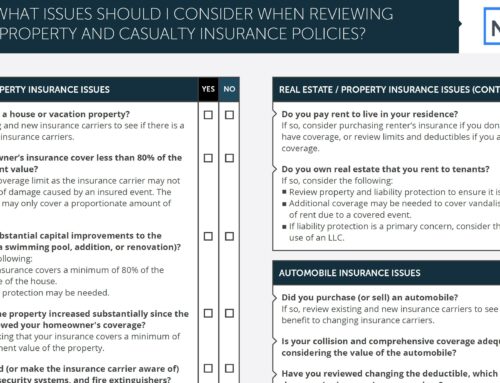Paying for Long-Term Care: A Comprehensive Guide
In part one of our series on Long-Term Care (LTC), we talked about the various LTC options and what makes up a good plan. You can find that here. This articles is about how to pay for long-term care and some of the recent state initiatives regarding a tax to pay for long-term care for the uninsured. I’ll also add a few thoughts regarding when to look at purchasing insurance, if that is part of your plan.
Options To Pay For Care
How to pay for long-term care is an increasingly relevant topic as the population ages. If you haven’t thought about it for yourself, maybe you’ve had to deal with it for a parent or other loved one. While understanding the necessity of such care is the first step, figuring out how to pay for it is the next challenging hurdle. Fortunately, there are multiple options available. Let’s look at some of the most popular options, from insurance solutions to self-funding.
1. Traditional Long-Term Care Insurance
Traditional LTC Insurance is a policy specifically designed to help cover costs associated with long-term care services that aren’t covered by regular health insurance or Medicare. This includes services in your home, a nursing home, a rehabilitation center, or an assisted living facility. Policyholders pay a regular premium to the insurance company, and when they require long-term care, they make a claim.
Coverage Options
There’s a variety of coverage options depending on the policy, but they often include:
Daily or Monthly Benefit: The maximum amount the policy will pay per day or month for care services.
Benefit Period: The length of time you’ll receive benefits from your policy, ranging from a few years to unlimited/lifetime coverage
Elimination Period: A sort of “deductible” period, where you cover your own care costs before the insurance kicks in. It’s typically 30, 60, or 90 days.
Inflation Protection: An option that increases your daily benefits over time to keep pace with the rising costs of care.
Qualifying For A Claim
To make a claim, the policyholder typically needs to demonstrate they cannot independently perform at least two of six “activities of daily living” (ADLs): bathing, dressing, transferring (e.g., moving from bed to chair), toileting, continence, and eating. Alternatively, claims may be made based on cognitive impairments like dementia or Alzheimer’s. A healthcare practitioner’s assessment and documentation are generally required.
Pros
Specific to long-term care, often covering a wide range of services.
Locks in benefits based on your health at the time of application.
Cons
Can be costly, especially if started later in life
Premiums may increase, and if you never use the care, there’s no return on the premiums paid
*** Federal Long-Term Care Insurance ***
For military, military retirees, and government civilians, there is the Federal Long Term Care Insurance Program . FLTCI is a traditional long-term care plan for individuals. The program is in a pause for new enrollees until December 2024 as they look to make it sustainable over the long term. This historically has been a very good deal for females because FLTCI charged the same rates for men and women. It’s unknown what the new program options will be, but there were several news articles recently that the rates existing policyholders were paying were increasing.
2. Hybrid Long-Term Care Insurance
Hybrid policies merge the benefits of life insurance with those of long-term care insurance. When the policyholder requires long-term care, the policy provides funds to cover those costs. If the policyholder never requires long-term care, it functions like a traditional life insurance policy, providing a death benefit to the named beneficiaries. If only a portion of the long-term care benefit is used, the remaining amount is typically paid as a death benefit.
Coverage Options
The coverage varies by policy but typically includes:
Death Benefit: A guaranteed amount payable to beneficiaries upon the policyholder’s death, reduced by any long-term care expenses incurred.
Long-term Care Benefits: The maximum amount the policy will pay for long-term care services. It can often exceed the death benefit.
Return of Premium: Some policies offer a feature where, if the policyholder changes their mind, they can retrieve most or all their premiums paid, though it might come at an additional cost.
Inflation Protection: To account for the rising costs of care over time.
Qualifying for a Claim
Like traditional long-term care insurance, policyholders usually qualify for benefits when they can’t independently perform at least two of the six ADLs or when they suffer from cognitive impairments. Documentation and a professional assessment are often required to initiate a claim.
Pros
Dual benefit – ensures a payout one way or another.
Premiums are typically locked in and won’t increase.
Cons
Initial premiums can be significantly higher than those of traditional policies.
The death benefit might be reduced if the long-term care portion is used.
*** When buying insurance, it’s crucial to work with a knowledgeable insurance agent or broker who can explain the intricacies of each policy and help identify the best fit for individual needs.
3. Self Funding
Self-funding using aside personal savings or assets to cover potential long-term care costs. This is optimal for people who have a significant retirement nest-egg or guaranteed income and are not concerned setting aside a portion of it should they need long-term care. This is also the inadvertent default for those who don’t plan or the reluctant choice for those who can’t afford long-term care insurance.
Pros
Flexibility in choosing care options without the limitations that insurance policies may impose.
No need to deal with premiums or insurance companies.
Cons
Requires significant personal savings.
The risk of running out of funds, especially if care is needed for an extended period.
4. Reverse Mortgages
A reverse mortgage is a financial tool tailored for homeowners, typically seniors aged 62 and older, allowing them to convert a portion of their home equity into cash. The funds can be used for any purpose, including long-term care. The amount one can borrow is determined by factors such as the home’s value, the borrower’s age, and prevailing interest rates. These funds can be disbursed as a lump sum, monthly payments, or a line of credit. The loan becomes due and payable when the homeowner either sells the home, moves out, or passes away. While reverse mortgages offer an avenue to tap into home equity without selling, it’s essential for potential borrowers to understand the associated fees, interest accumulation, and potential impacts on their estate and any public assistance benefits they may be receiving.
Pros
Provides a way to access funds without selling the home.
Loan repayment is deferred until the homeowner sells the home, moves out, or passes away.
Cons
Can deplete the equity in the home, impacting potential inheritance.
Usually comes with various fees and can affect eligibility for certain assistance programs.
The reverse mortgage industry has a poor reputation and some of their products were not very good for borrowers. This has improved over the last few years and there are some products available that can make this an OK option.
5. Annuities
An annuity is an insurance product where you give an insurance company a sum of money (can be one-time or over a recurring period of time) and they agree to provide you a stream of income at some point in the future. There are specific annuities designed for long-term care. This is sometimes an option if you can’t qualify for either LTC insurance or hybrid life/LTC insurance.
Pros
Offers a predictable revenue source.
Some annuities are structured to provide increased benefits if long-term care is needed.
Cons
Requires a significant upfront investment.
The return on investment can be lower compared to other financial instruments.
6. Medicaid
While many people mistakenly believe that Medicare will provide LTC benefits, it does not. However, Medicaid will provide LTC benefits. Medicaid is a state and federally funded program primarily covering medical costs for eligible individuals. It will also provide LTC benefits. The qualifications are stringent, particularly regarding income and assets so this is typically the last resort for most people.
Pros
Can cover extensive long-term care costs, even beyond what some insurance policies would cover.
Cons
Stringent eligibility requirements, particularly regarding income and assets.
May limit the care options or facilities available to recipients.
7. VA Long-Term Care Options
The U.S. Department of Veterans Affairs (VA) offers a range of long-term care options tailored to meet the needs of veterans and, in certain cases, their spouses. Recognizing the unique challenges that veterans face, the VA provides services spanning from in-home care to community living centers (essentially, VA-operated nursing homes). These offerings include Home-Based Primary Care, Adult Day Health Care, and Respite Care, designed to aid those who prefer or need to remain at home. For veterans who require more intensive or round-the-clock care, the VA operates community living centers that cater to various needs, from rehabilitation to hospice care. Additionally, for those who prefer care in a non-VA environment, the Aid & Attendance benefit can provide supplementary funds.
Pros
Significant suite of services across all levels of needed care
Cons
Eligibility based on clinical need, availability, and the veteran’s priority group
Options Wrap Up
The costs associated with long-term care can be daunting, but with the right strategy, they become manageable. Whether it’s through insurance, self-funding, or other financial instruments, the key is to start planning early. Engage with financial advisors or professionals to tailor the best approach for your unique circumstances. Remember, the goal is not just to fund care, but to ensure quality and peace of mind in later life.
Legislative Changes
The growing concern surrounding long-term care (LTC) and its affordability has led several states in the US to take action either by implementing taxes or promoting Long-Term Care Insurance (LTCI). States face increasing Medicaid costs from the uninsured. The efforts seek to addressing the financial challenges that come with the rising demand for long-term care services. Here’s a closer look at these initiatives:
Washington State
Washington pioneered this movement by introducing a payroll tax to fund long-term care benefits. Effective July 1, 2023, Washington workers are taxed $0.58 per $100 of their earnings, which goes into the Washington Cares Fund. The first benefits from this fund will become available in July 202. For young, higher income earners, this can be significantly more expensive than LTC insurance.
Other States Following Suit
Inspired by Washington’s initiative, 19 states including California, New York, Pennsylvania, Illinois, Michigan, and Minnesota are considering similar measures to tax individuals who do not own Long-Term Care Insurance. While Washington allowed some time to establish LTC insurance to avoid the tax, some of the other state proposals do not and may simply you had LTC insurance prior to the legislation passing.
The moves by these states underline a growing recognition of the long-term care challenge. Too many individuals haven’t planned for long-term care and late in life introduce increase burden on their families and or the state through Medicaid. The goal is a more sustainable system, but its not yet clear whether this will be successful or another program taxing workers.
Answers To A Few Questions Regarding LTC Insurance
If I’m considering insurance, when should I get it?
There is not specific age, but most experts suggest that getting coverage between your mid-50s to early 60s is preferable. Premiums will be more reasonable because you still have a while until you’re expected to need care. You’re also (hopefully) healthy enough to qualify for insurance. As you get older you’re also more likely to develop disqualifying medical issues.
What is the elimination period?
Most LTC insurance contracts have a period in which you establish that you qualify for care, but before the payments begin. This is similar to a deductible for your home or auto policy. You will pay for care during this time. The longer the elimination period, the cheaper the premium (typically). Elimination periods of 30, 60, 90, and 180 days are common. Part of your plan should include budgeting for this time prior to LTC insurance starting to pay out.
What is the difference between a reimbursement or indemnity policy?
An LTC insurance policy is typically either a reimbursement or indemnity policy. A reimbursement policy will only pay for actual-costs based on a claim that you submit, typically monthly. An indemnity policy pays a set amount of benefits based on a daily or monthly amount of benefits defined in the policy. Indemnity policies are much easier to deal with than having to submit receipts and track care. Once you qualify for a claim, they will just pay out as long as you continue to qualify.




